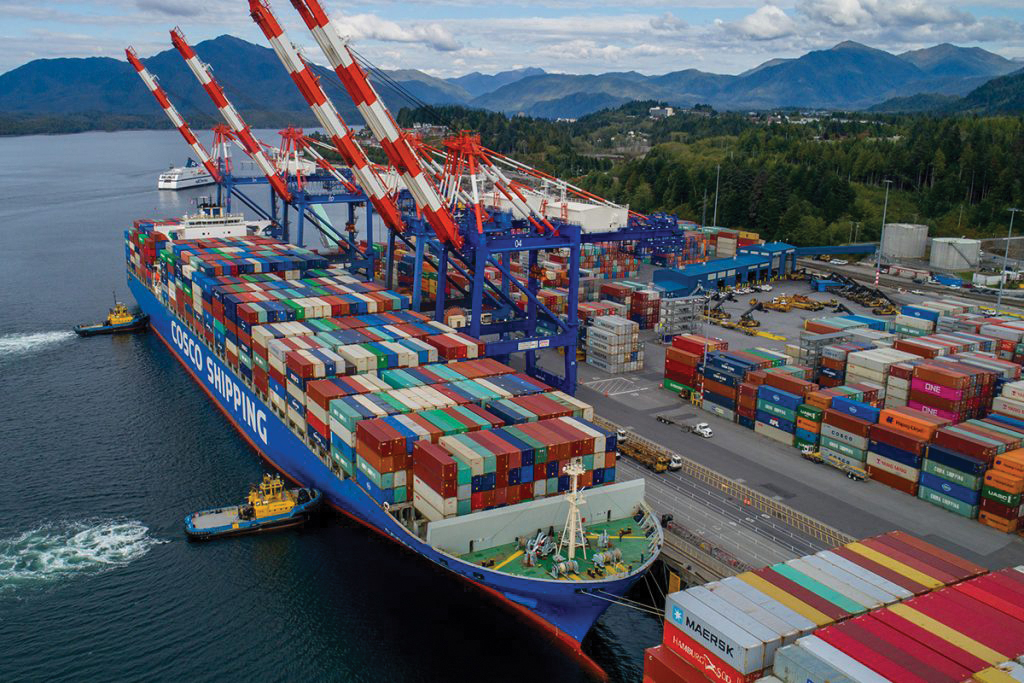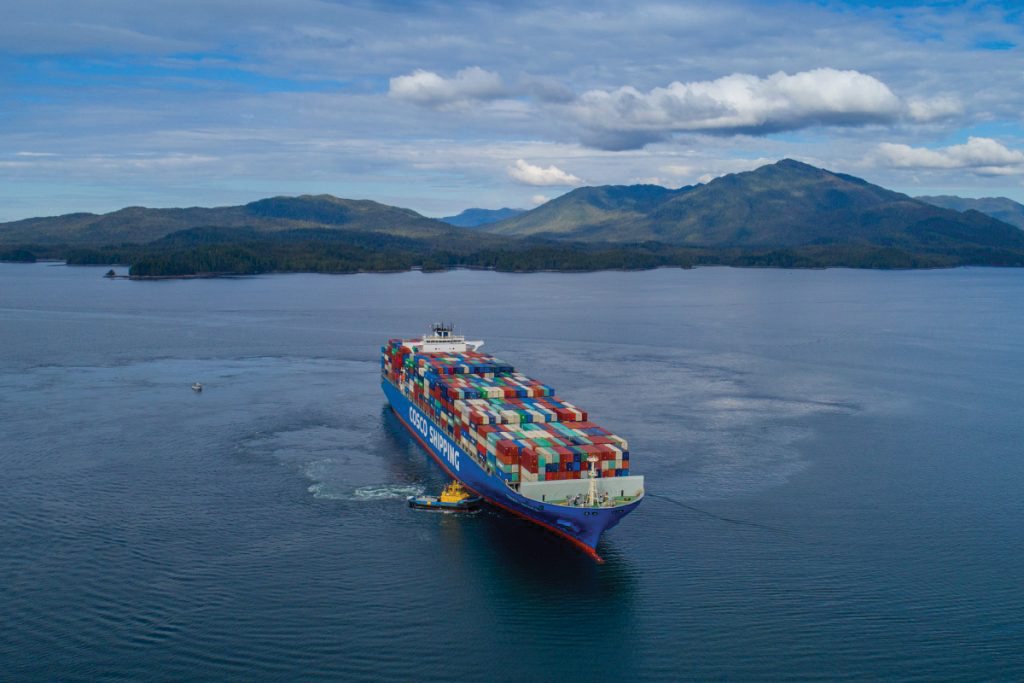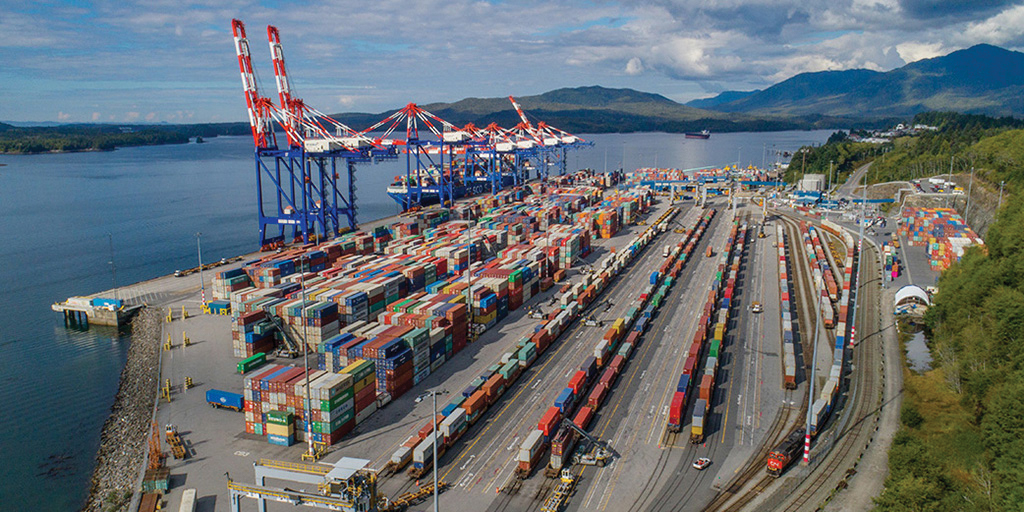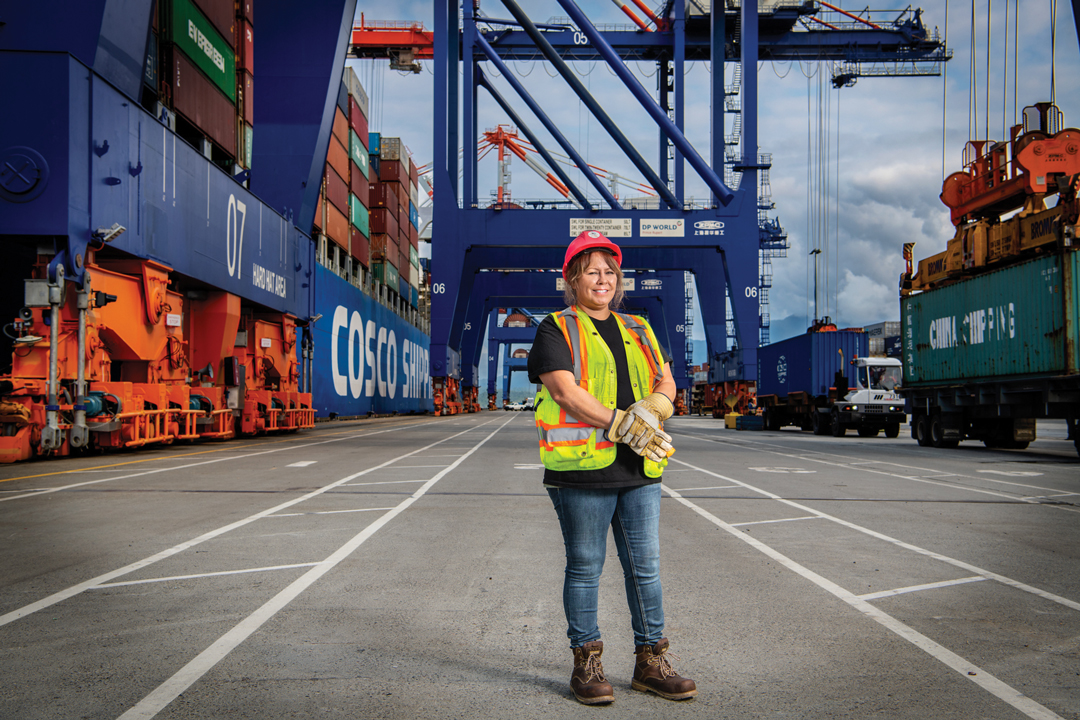THE OTHER WEST COAST PORT
BY MADELEINE BAERG • PHOTOS COURTESY OF PRINCE RUPERT PORT AUTHORITY
The Port of Prince Rupert is a remote but critical link in the Canadian crop export chain. Located in Prince Rupert Harbour just south of the Alaska Panhandle on British Columbia’s rugged Pacific coastline, its facilities are strung along a 20-kilometre stretch of Kaien Island, adjacent to the Prince Rupert townsite.
A lesser-known departure point for Canadian grain exports, the Port has capacity to move approximately 7.5 million tonnes of grain annually, and it ranks third in shipped grain tonnage behind sister ports in Vancouver and Thunder Bay. While the Port has no control over rail capacity, it may prove a limiting factor in the export of the 2022 grain harvest.
For their part, the Port and Prince Rupert Grain Terminal (PRGT) are ready and able to serve the export needs of grain companies, according to Port officials. “Rupert plays a really important role so that shippers have more than one option on the West Coast,” said Brian Friesen, vice-president of trade development and real estate for the Prince Rupert Port Authority. This market access diversification is critical for Canadian grain exports and the wide range of other goods shipped through the Port’s terminals. Such products include containerized consumer goods, bulk wood pellets and liquid propane.
The Port offers the shortest and fastest trade route from North America’s West Coast to markets in Asia and the Middle East. The ocean voyage for trade vessels is 40 hours shorter from Prince Rupert to Shanghai than it is from Vancouver. Its naturally wide and protected shipping approaches make it possible to successfully berth in just two hours. This is half the time typically required to settle in at the Port of Vancouver and a quarter that of the Port of Seattle. Being the deepest natural harbour in North America, it is inherently safer than shallower ports and can accommodate the largest shipping vessels.
Arguably, the Port of Prince Rupert’s main selling feature is that it isn’t the Port of Vancouver. “There’s so much congestion now at the Port of Vancouver because a number of Canadian exporters put their products through the Port and, of course, the big bottleneck is the rail service into the Port of Vancouver,” said Jason Fletcher, president of Prince Rupert Grain, the corporation that owns and operates the PRGT. “For an exporting nation like ours, it’s a very big deal. Anything that shippers can do to help the railways with another conduit to tidewater is immensely important.”

In addition to taking pressure off the Port of Vancouver, Prince Rupert is vital to keep ships moving when crisis strikes. “For Canada, having two ports on the West Coast is critical for supply chain resiliency and our ability to continue to serve international markets,” said Friesen. “We saw that really punctuated with the unfortunate flooding and washout events late last year, which really had a significant impact on rail operations in and out [of the Port of Vancouver]. In that case, Rupert wasn’t impacted and cargo was still able to flow.”
The Port of Prince Rupert links North America’s most northerly rail line to the rest of the world. In the Second World War, it served as a critical launchpad to key conflict points in Asia. Its first shipping terminal, the Fairview Terminal, was completed in 1975. However, it wasn’t until the late 1990s when the Port Authority was established that the Port became a recognized international trade gateway.
The Port Authority, which answers to the federal minister of transportation, ensures the facility runs safely and efficiently and acts as a landlord to its six tenant terminals. Each of these is responsible for its own handling and co-ordination of shipments.
The Port’s grain handling hub, the PRGT was built in 1985. It is operated as a joint venture by majority occupant Viterra and tenants Cargill and the Richardson Group. PRGT primarily handles Prairie wheat, barley and canola, as well as feed screenings and other byproducts.
PRGT boasts the highest throughput of any grain-cleaning elevator in Canada. Its state-of-the-art equipment can clean more than 13 railcars of grain per hour, essentially as fast as they can be unloaded. The terminal is equipped with eight shipping bins and three tower-mounted loading spouts, which together can load up to 4,000 tonnes per hour into waiting ships. While annual shipping totals depend on crop yield, an average year sees the flow of between 5.5 million and six million tonnes.
A complement to bulk shipment, the export of containerized grain has become a secondary option for Canadian exporters and the means to serve a wider array of customers. The shipment of bagged grain in 20-foot containers offers certain advantages. These include identity preservation, small-lot capacity, the ability to trade in-transit and more. They have become an increasingly attractive means to ship high-end and commodity grain as well as grain products, though containerized shipping remains a very small part of overall grain shipping in Canada.
DP World’s Fairview Container Terminal, the Port of Prince Rupert’s sole container terminal, recently completed a major expansion that increased its capacity from 1.35 million 20-foot container equivalent units (TEU) to 1.6 million TEU. A second expansion, scheduled for completion within the next several years will bring total capacity to between 1.8 and 2 million TEU.
Because the Port is not constricted by existing urban development, potential also exists to construct entirely new terminals. While there is no need for a second grain terminal now, Fletcher said there is room to expand the existing facility when the tenants see value in the investment.

A second container facility is a top priority, however, and a feasibility assessment is currently underway. Friesen believes Prince Rupert is the single best location for a new container terminal anywhere on the West Coast of North America. Contributing factors include existing road and rail infrastructure adjacent to the site and good coastal geography with deep water. And though the Port is conveniently close to its namesake city, its largely rural setting offers relatively low projected construction costs.
Plans for a 70-acre transloading logistics site are also in the works. Construction of the massive, multimillion-dollar facility is set to begin construction in coming months and should be operational by 2026. Dubbed the Ridley Island Export Logistics project, it will be able to handle entire trainloads and load bulk cargo into containers prior to shipping. Of the 400,000 TEUs the facility should fill annually, approximately 150,000 will be grain.
“A significant component [of the new facility’s capacity] will be a grain transload facility purpose-built and on a scale that doesn’t exist today. It will be a game changer for agricultural exporters to be able to send full unit trains of grain exports to this facility to have them containerized and then find market access,” said Friesen.
The Port holds an aggressive and future-focused growth strategy for its entire portfolio, which has ambitions to reach annual capacity of 50 million tonnes by 2032, if not sooner. “Beyond that, through the 2030s and the 2040s, we see that growth continuing in a major way,” said Friesen.
“Port projects take a long time. We’re really, really focused on long-term planning. The next decade [will] set up the two or three after that. We’re looking well out into the future to ensure Canada’s trade needs are met.”
To this end, plans are in the works, and in several instances, construction is underway to build capacity through expansion or, as mentioned, the creation of new terminals, and to enhance road and rail infrastructure to service these terminals. “We’re looking at $2.5 billion worth of projects either in the ground today or close to final decisions,” said Friesen. “We’re laser focused on the opportunity we have to attract private sector investments into new terminal infrastructure.”
Both the federal and provincial governments have stepped up to ensure adequate infrastructure is in place at the Port for growth to proceed. Ottawa has committed $153.7 million through the National Trade Corridors Fund to support a rail bridge expansion and enhanced logistics facilities at the Port. “There’s certainly a recognition at Transport Canada and the federal government about the importance of the Port of Prince Rupert and pursuing Canada’s agenda with respect to trade, market access and supply chain resiliency to ensure Canada has two large scale, viable port options on the West Coast,” said Friesen. “Prince Rupert is where much of that growth in Canadian export capacity is going to happen.” While Friesen said these growth plans are exciting, uncertainty surrounding regulatory approvals remains a key impediment to expeditious growth of capacity. “We’ll need to go through an entire project development lifecycle, including environmental reviews, but hopefully we can get that terminal up and running by about 2030,” he said.

RAIL ACCESS
The Port of Prince Rupert is serviced exclusively by CN Rail. The rail line across the Rockies to tidewater has much gentler grades than southern rail routes to Vancouver and Seattle. This allows the Port to be serviced by longer trains that burn relatively less fuel. To encourage shippers to decrease pressure on the Port of Vancouver, CN incentivizes certain contracts for Prince Rupert with lower rates.
Friesen commended CN for keeping cargo rolling on a regular basis. He also cheered the railway’s continued capital investment in its northern mainline, including additional rail sidings that will support ongoing growth and efficiency of Port operations. “We live and die by rail up here. And to that end, we’ve got a great partner in CN,” he said.
Not everyone is as confident in CN’s ability to keep up with the Port’s shipping needs.
Mark Hemmes is president of Quorum Corporation, which is tasked by Transport Canada and Agriculture and Agri-Food Canada to monitor and report on western Canadian grain handling and transportation. Hemmes said while expansion is exciting for the Port of Prince Rupert and positive for Canadian exports in general, rail capacity has become a limiting factor. A decade ago, grain was the major product that flowed through the Port. Today, grain cars compete for loading and unloading space with many non-agricultural goods.
“Because of all that expansion, because of that increase in the amount of traffic going through there, the whole rail capacity issue has become more of a concern for the industry as a whole, and not just the grain industry,” he said. “I think a lot of people are concerned, including CN. They’re the only game in town, so they really are working hard at increasing the capacity and the flow.”
The capacity issue isn’t really about the number of railcars that can traverse a given piece of track, said Hemmes. Rather, the challenge is co-ordination and timing. “Rail capacity is something of a black art. It’s got to be the proper mix of the right number of crews, of cars and the way they flow the trains into the terminal. In the last couple of years, the grain industry has wanted to put more traffic through Prince Rupert but, unfortunately, that capacity isn’t available.”
Like Friesen, Hemmes gives CN credit for its financial investment in increased capacity through new sidings and improved signals, he also believes the railway faces a challenging time given the expected dramatic increase in crop yield over that of last year. “I do think we’re heading into a pretty difficult year.”
Wade Sobkowich, executive director of the Western Grain Elevator Association, agreed and framed the problem in starker terms. Though he conceded circumstances in 2021, such as the B.C. floods, were beyond the control of the railways, he said CN and CP, though CP doesn’t service Prince Rupert, lacked resiliency and service was slow to recover during the winter. He worries staff reductions last year may not have been brought back in sufficient number to handle the increased load. “We are very concerned about rail capacity in all corridors, frankly,” he said. “If the railways couldn’t serve us last year, what confidence do we have they’ll serve us this year?”
Inadequate rail capacity is a key reason the Port of Prince Rupert received a very low ranking on the World Bank’s 2021 Container Port Performance Index. The annual ranking compares operational performance, efficiency, access, oversight, co-ordination, predictability and reliability of the world’s major container ports. Of the 370 ranked, Prince Rupert placed 344. At 368, Vancouver landed in the bottom three with Long Beach and Los Angeles.
Ultimately, rail capacity frustrations at the ports impact farmers. “Grain companies sell based on what they think they’re going to get for rail capacity, so accurate information from the railways on what they’re going to supply is very, very important,” said Sobkowich. “Shipping failures get reflected in the basis and reflected in prices to farmers.”
Smooth shipping is more critical on a global basis than ever, given lost grain production and movement capacity in Ukraine. “It’s a really important year for Canada to be able to actively participate in the global grain system,” said Hemmes. “Obviously, Canada can’t make up for what’s lost there, but we can sure contribute. If we don’t have an adequate logistics system in place that’s going to be able to let us do that, the world is going to be in a worse place.”
A PROVEN TRADE LINK
Rail access troubles aside, the Port has proven its capacity as a market conduit for Canadian crops for more than three decades. It operated at full capacity through the stress and uncertainty of the pandemic, thanks to the commitment of its staff as well as longshore, terminal and marine workers, said the PRGT’s Jason Fletcher.
“They weren’t classified as essential workers, but they very much were. Those terminals never stopped. They ran 24/7 all the way through. That shows the resiliency of the operation and of the people. As an exporting nation, that is just critical.”







Comments